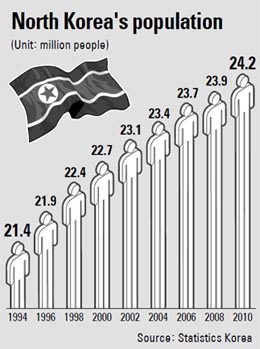Study puts spotlight on effects of North’s famine

North Korea’s population was 24.19 million in 2010, 49.5 percent of the South’s 48.88 million, according to a report from Statistics Korea. There are 11.79 million men and 12.39 million women in the North.
The statistics are based on population censuses conducted in 1993 and 2008 by North Korea and the United Nations Population Fund.
“North Korea clearly reflects the societal changes in its population,” the report said, adding that there is almost no immigration or emigration.
The deadly famine of the last decade started in the early 1990s and worsened in 1997 and 1998, leading to a large population loss. About 480,000 people died between 1994 and 2005 as a result of the famine, the report said. The country also recorded 130,000 fewer births than normal between 1995 and 2004.
The famine resulted in a high mortality rate among infants and young children as well as seniors, according to the report. Pregnant women were perhaps worst off, experiencing malnutrition that often resulted in deaths of both the mother and unborn child. Also, based on a survey of North Korean defectors to South Korea, the average height and weight of a younger North Korean is significantly lower than their South Korean counterparts.
Life expectancy for North Korean men dropped to 59.5 years in 1998 from 67 in 1993. Life expectancy improved a little after 1998 but has not recovered to 1990s levels.
Life expectancy for South Korean males in 2010 is 76.2, 11 years longer than for North Koreans. For female South Koreans, life expectancy is 82.9, again 11 years longer than in North Korea.
In terms of height and weight, North Korean male defectors aged 19 to 29 were 8.8 centimeters (3.5 inches) shorter than South Koreans and 14.3 kilograms (31.5 pounds) lighter, while North Korean women were 6.5 centimeters shorter than their southern counterparts and 4.5 kilograms lighter.
North Korea’s fertility rate also fell to 1.96 in 1998 from 2.17 in 1993 and recovered a little to 2.02 in 2008.
However, the median age in North Korea was lower than in South Korea in 2010. North Korean men’s median age was 30.1, which is 6.8 years younger than South Korea’s, and North Korean women’s median age was 33.7, 5.3 years lower.
By Limb Jae-un [jbiz91@joongang.co.kr]










with the Korea JoongAng Daily
To write comments, please log in to one of the accounts.
Standards Board Policy (0/250자)